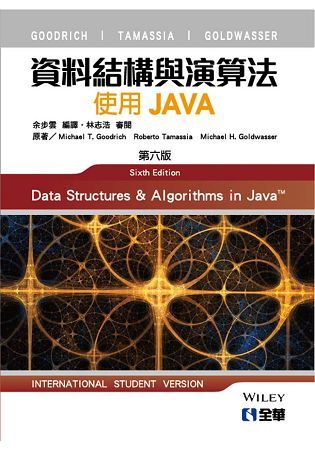本書為Goodrich、Tamassia與Goldwasser累積多年經驗,根據JAVA 7.0程式語言之需求,所撰寫關於資料結構與演算法之書籍。內容架構完整,鉅細靡遺。並透過書中的圖片及教學網站的解說使讀者清楚了解資料結構與演算法的觀念。並附有精選習題,課後立即複習,加強實力。
本書特色
1.本書為Goodrich、Tamassia與Goldwasser累積多年經驗,根據JAVA 7.0程式語言之需求,所撰寫關於資料結構與演算法之書籍。
2.書中程式碼與例題均能將JAVA7.0版本之特色呈現出來。
3.透過書中的圖片,清晰的解說資料結構與演算法的觀念。
4.藉由數百個精選的習題,以增強讀者暸解概念。
5.新增符合目前科技發展的專題研究題目。
| FindBook |
有 9 項符合
資料結構與演算法:使用JAVA(第六版)的圖書 |
 |
資料結構與演算法:使用JAVA(第六版) 作者:佘步雲 出版社:全華圖書股份有限公司 出版日期:2018-01-15 語言:繁體書 |
| 圖書選購 |
| 型式 | 價格 | 供應商 | 所屬目錄 | 二手書 |
$ 424 |
二手中文書 |
$ 621 |
科學科普 |
$ 621 |
資訊 |
$ 621 |
程式語言 |
$ 655 |
中文書 |
$ 656 |
資訊 |
$ 656 |
資訊學群 |
$ 656 |
高等教育 |
$ 690 |
資訊學群 |
|---|
| 圖書館借閱 |
| 國家圖書館 | 全國圖書書目資訊網 | 國立公共資訊圖書館 | 電子書服務平台 | MetaCat 跨館整合查詢 |
| 臺北市立圖書館 | 新北市立圖書館 | 基隆市公共圖書館 | 桃園市立圖書館 | 新竹縣公共圖書館 |
| 苗栗縣立圖書館 | 臺中市立圖書館 | 彰化縣公共圖書館 | 南投縣文化局 | 雲林縣公共圖書館 |
| 嘉義縣圖書館 | 臺南市立圖書館 | 高雄市立圖書館 | 屏東縣公共圖書館 | 宜蘭縣公共圖書館 |
| 花蓮縣文化局 | 臺東縣文化處 |
|
|
圖書介紹 - 資料來源:博客來 評分:
圖書名稱:資料結構與演算法:使用JAVA(第六版)
內容簡介
目錄
Chapter 1 Java程式基礎
1.1 初步(Preliminaries)
1.1.1 基本型態(Base Types)
1.2 物件和類別(Objects and Classes)
1.2.1 建立和使用物件(Creating and Using Objects)
1.2.2 定義類別(Defining a Class)
1.3 特殊型態(Special Types)
1.4 Java 運算式(Java Expressions)
1.4.1 字面文字(Literals)
1.4.2 運算子(Operators)
1.4.3 型態轉換(Type Conversions)
1.5 控制流程(Control Flow)
1.5.1 If和Switch敘述(The If and Switch Statements)
1.5.2 迴圈(Loops)
1.5.3 顯式控制流敘述(Explicit Control-Flow Statements)
1.6 輸入和輸出(Input and Output)
1.7 Java 套件(Java Packages)
1.8 編寫Java 程式(Writing a Java Program)
1.8.1 設計(Design)
1.8.2 虛擬程式碼(Pseudocode)
1.8.3 撰寫程式(Coding)
1.8.4 文件和樣式(Documentation and Style)
1.8.5 測試和除錯(Testing and Debugging)
1.9 習題
Chapter 2 物件導向設計
2.1 目標、原則與設計模式(Goals, Principles, and Patterns)
2.1.1 物件導向設計目標(Object-Oriented Design Goals)
2.1.2 物件導向設計原則(Object-Oriented Design Principles)
2.1.3 設計模式(Design Patterns)
2.2 繼承(Inheritance)
2.2.1 Credit Card類別擴展(Extending the CreditCard Class)
2.2.2 多型與動態配置(Polymorphism and Dynamic Dispatch)
2.2.3 繼承階層(Inheritance Hierarchies)
2.3 介面與抽象類別(Interfaces and Abstract Classes)
2.3.1 java中的介面(Interfaces in Java)
2.3.2 介面的多重繼承(Multiple Inheritance for Interfaces)
2.3.3 抽象類別(Abstract Classes)
2.4 異常(Exceptions)
2.4.1 捕捉異常(Catching Exceptions)
2.4.2 拋出異常(Throwing Exceptions)
2.4.3 Java 異常階層(Java's Exception Hierarchy)
2.5 轉型與泛型(Casting and Generics)
2.5.1 轉型(Casting)
2.5.2 泛型(Generics)
2.6 巢狀類別(Nested Classes)
2.7 習題
Chapter 3 陣列與鏈結串列
3.1 陣列的實際用法(Practical Uses of Arrays)
3.1.1 在陣列存放遊戲記錄(Storing Game Entries in an Array)
3.1.2 陣列排序(Sorting an Array)
3.1.3 用於陣列隨機數值的java.util方法(java.util Methods for Arrays and Random Numbers)
3.1.4 使用字串和字元陣列的簡單密碼學(Simple Cryptography with Strings and Character Arrays)
3.1.5 二維陣列和定位遊戲(Two-Dimensional Arrays and Positional Games)
3.2 單向鏈結串列(Singly Linked Lists)
3.2.1 實現單向鏈結串列(Implementing a Singly Linked List Class)
3.3 環狀鏈結串列(Circularly Linked Lists)
3.3.1 循環式排程(Round-Robin Scheduling)
3.3.2 設計與實現環狀鏈結串列(Designing and Implementing a Circularly Linked List)
3.4 雙向鏈結串列(Doubly Linked Lists)
3.4.1 實現雙向鏈結串列(Implementing a Doubly Linked List Class)
3.5 測試相等性(Testing for Equality)
3.5.1 測試陣列的相等性(Equivalence Testing with Arrays)
3.5.2 測試鏈結串列的相等性(Equivalence Testing with Linked Lists)
3.6 複製資料結構(Copying Data Structures)
3.6.1 複製陣列(Cloning Arrays)
3.6.2 複製鏈結串列(Cloning Linked Lists)
3.7 習題
Chapter 4 分析工具
4.1 實證分析(Empirical Analysis)
4.1.1超越實驗分析(Moving Beyond Experimental Analysis)
4.2 常用數學函式(Common Mathematical Functions)
4.2.1比較成長速率(Comparing Growth Rates)
4.3 Big-Oh 表示法(Big-Oh Notation)
4.3.1定義Big-Oh符號(Defining the “Big-Oh” Notation)
4.3.2比較分析(Comparative Analysis)
4.3.3演算法分析範例(Examples of Algorithm Analysis)
4.4 證明方法(Proof Methods)
4.4.1 實例證明(By Example)
4.4.2 反向證明法(The Contra Attack)
4.4.3 歸納法及迴圈不變式(Induction and Loop Invariants)
4.5 習題
Chapter 5 遞迴
5.1 遞迴基礎(Foundations of Recursion)
5.1.1 階乘函數(The Factorial Function)
5.1.2 描繪英制尺(Drawing an English Ruler)
5.1.3 二元搜尋(Binary Search)
5.1.4 檔案系統(File Systems)
5.2 遞迴分析(Recursive Analysis)
5.3 遞迴的應用(Applications of Recursion)
5.3.1 線性遞迴(Linear Recursion)
5.3.2 二元遞迴(Binary Recursion)
5.3.3 多重遞迴 (Multiple Recursion )
5.4 使用遞迴(Using Recursion)
5.5 遞迴的陷阱(Pitfalls of Recursion)
5.5.1 Java中的最大遞迴深度(Maximum Recursive Depth in Java)
5.6 習題
Chapter 6 堆疊與佇列
6.1 堆疊(Stacks)
6.1.1 堆疊抽象資料型態(The Stack Abstract Data Type)
6.1.2 用陣列完成的簡單堆疊實作(A Simple Array-Based Stack Implementation)
6.1.3 用鏈結串列完成堆疊實作(Implementing a Stack with a Singly Linked List)
6.1.4 括號及HTML 標籤配對(Matching Parentheses and HTML Tags)
6.2 佇列(Queues)
6.2.1 佇列抽象資料型態(The Queue Abstract Data Type)
6.2.2 利用陣列完成佇列實作(Array-Based Queue Implementation)
6.2.3 使用單向鏈結串列實作佇列(Implementing a Queue with a Singly Linked List)
6.2.4 迴圈佇列(A Circular Queue)
6.3 雙向佇列(Double-Ended Queues)
6.3.1 雙向佇列抽象資料型態(The Deque Abstract Data Type)
6.3.2 雙向佇列實作(Implementing a Deque)
6.3.3 Java集合架構中的雙向佇列(Deques in the Java Collections Framework)
6-4 習題
Chapter 7 串列抽象
7.1 串列ADT(The List ADT)
7.2 基於陣列的串列(Array-based Lists)
7.2.1 動態陣列(Dynamic Arrays)
7.2.2 實現動態陣列(Implementing a Dynamic Array)
7.2.3 動態陣列的攤銷分析(Amortized Analysis of Dynamic Arrays)
7.2.4 Java的StringBuilder類別
7.3 基於位置的串列(Position-Based Lists)
7.3.1 位置(Positions)
7.3.2 位置串列抽象資料型態(The Positional List Abstract Data Type)
7.3.3 雙向鏈結串列實現(Doubly Linked List Implementation)
7.4 迭代器(Iterators)
7.4.1 可迭代介面和Java的For-Each迴圈(The Iterable Interface and Java's For-Each Loop)
7.4.2 實現迭代器(Implementing Iterators)
7.5 群集架構(The Collections Framework)
7.5.1 列出Java中的迭代器(List Iterators in Java)
7.5.2 與Positional List ADT做比較(Comparison to Our Positional List ADT)
7.5.3 Java群集架構中基於串列的演算法(List-Based Algorithms in the Java Collections Framework)
7.6 習題
Chapter 8 樹結構
8.1 樹的定義和性質(Trees Definitions and Properties)
8.1.1 樹抽象資料型態(The Tree Abstract Data Type)
8.1.2 計算深度和高度(Computing Depth and Height)
8.2 二元樹(Binary Trees)
8.2.1 二元樹抽象資料型態(The Binary Tree Abstract Data Type)
8.2.2 二元樹的性質(Properties of Binary Trees)
8.3 樹的表示方式(Tree Representations)
8.3.1 二元樹的鏈結結構(Linked Structure for Binary Trees)
8.3.2 基於陣列的二元樹表示方式(Array-Based Representation of a Binary Tree)
8.3.3 一般樹的鏈結結構(Linked Structure for General Trees)
8.4 樹遍訪演算法(Tree Traversal Algorithms)
8.4.1 一般樹的前序和後序遍訪(Preorder and Postorder Traversals of General Trees)
8.4.2 廣度優先樹遍訪(Breadth-First Tree Traversal)
8.4.3 二元樹的中序遍訪(Inorder Traversal of a Binary Tree)
8.4.4 在Java中實現樹的遍訪(Implementing Tree Traversals in Java)
8.4.5 樹遍訪的應用(Applications of Tree Traversals)
8.4.6 歐拉之旅(Euler Tours)
8.5 習題
Chapter 9 堆積和優先佇列
9.1 優先佇列抽象資料型態(The Priority Queue Abstract Data Type)
9.1.1 優先事項(Priorities)
9.1.2 優先佇列ADT(The Priority Queue ADT)
9.2 實施優先佇列(Implementing a Priority Queue)
9.2.1 項目複合(The Entry Composite)
9.2.2 使用全序比較鍵值(Comparing Keys with Total Orders)
9.2.3 AbstractPriorityQueue基礎類別(The AbstractPriorityQueue Base Class)
9.2.4 使用未排序的串列實現優先佇列(Implementing a Priority Queue with an Unsorted List)
9.2.5 使用排序串列實現優先佇列(Implementing a Priority Queue with a Sorted List)1
9.3 堆積(Heaps)
9.3.1 堆積資料結構(The Heap Data Structure)
9.3.2 使用堆積實現優先佇列(Implementing a Priority Queue with a Heap)
9.3.3 基於堆積的優先佇列的分析(Analysis of a Heap-Based Priority Queue)
9.3.4 自下而上的堆積構造 (Bottom-Up Heap Construction)
9.3.5 使用java.util.PriorityQueue類別
9.4 使用優先佇列排序(Sorting with a Priority Queue)
9.4.1 選擇排序和插入排序(Selection-Sort and Insertion-Sort)
9.4.2 堆積排序(Heap-Sort)
9.5 適應性優先佇列(Adaptable Priority Queues)
9.5.1 位置感知項目(Location-Aware Entries)
9.5.2 實現適應性優先佇列(Implementing an Adaptable Priority Queue)
9.6 習題
Chapter 10 雜湊表、MAP與跳躍串列
10.1 Map 抽象資料型態(The Map Abstract Data Type)
10.1.1 Map ADT
10.1.2 應用:計數單字頻率(Application: Counting Word Frequencies)
10.1.3 AbstractMap基礎類別(An AbstractMap Base Class)
10.1.4 簡單的未排序map實作(A Simple Unsorted Map Implementation)
10.2 雜湊(Hashing)
10.2.1 雜湊函數(Hash Functions)
10.2.2 碰撞處理方案(Collision-Handling Schemes)
10.2.3 負載因子,重組和效率(Load Factors, Rehashing, and Efficiency)
10.2.4 Java雜湊表實作(Java Hash Table Implementation)
10.3 排序圖抽象資料型態(The Sorted Map Abstract Data Type)
10.3.1 排序搜尋表(Sorted Search Tables)
10.3.2 排序map的應用(Applications of Sorted Maps)
10.4 跳躍串列(Skip Lists)
10.4.1 跳躍串列中的搜尋和更新操作(Search and Update Operations in a Skip List)
10.4.2 跳躍串列的機率分析( Probabilistic Analysis of Skip Lists)
10.5 Sets、 Multisets、和 Multimaps
10.5.1 Set ADT(The Set ADT)
10.5.2 Multiset ADT
10.5.3 Multimap ADT
10.6 習題
Chapter 11 搜尋樹結構
11.1 二元搜尋樹(Binary Search Trees)
11.1.1 在二元搜尋樹中搜尋(Searching Within a Binary Search Tree)
11.1.2 插入和刪除(Insertions and Deletions)
11.1.3 Java實作(Java Implementation)
11.1.4 二元搜尋樹的效能(Performance of a Binary Search Tree)
11.2 平衡搜尋樹(Java Framework for Balancing Search Trees)
11.2.1 用於平衡搜尋樹的Java架構(Java Framework for Balancing Search Trees)
11.3 AVL 樹(AVL Trees)
11.3.1 更新操作(Update Operations)
11.3.2 Java實作(Java Implementation)
11.4 (2,4) 樹
11.4.1 多路搜尋樹(Multiway Search Trees)
11.4.2 (2,4)樹操作((2,4)-Tree Operations)
11.5 紅黑樹(Red-Black Trees)
11.5.1 紅黑樹操作(Red-Black Tree Operations)
11.5.2 Java實作(Java Implementation)
11.6 伸展樹(Splay Trees)
11.6.1 伸展(Splaying)
11.6.2 何時伸展(When to Splay)
11.6.3 Java實作(Java Implementation)
11.6.4 伸展攤銷分析(Amortized Analysis of Splaying)
11.7 習題
Chapter 12 字串與動態規劃
12.1 序言(Preliminaries)
12.1.1 文字字串符號(Notations for Character Strings)
12.2 樣式- 匹配演算法(Pattern-Matching Algorithms)
12.2.1 暴力法(Brute Force)
12.2.2 Boyer-Moore演算法(The Boyer-Moore Algorithm)
12.2.3 Knuth-Morris-Pratt演算法
12.3 Tries 樹(Tries)
12.3.1 標準tries 樹(Standard Tries)
12.3.2 壓縮tries (Compressed Tries)
12.3.3 字尾tries (Suffix Tries)
12.3.4 搜尋引擎索引(Search Engine Indexing)
12.4 文字壓縮和貪婪法(Text Compression and the Greedy Method)
12.4.1 霍夫曼編碼演算法(The Huffman Coding Algorithm)
12.4.2 貪婪法(The Greedy Method)
12.5 動態規劃(Dynamic Programming)
12.5.1 矩陣鏈乘法(Matrix Chain-Product)
12.5.2 DNA和文字序列校對(DNA and Text Sequence Alignment)
12.6 習題
Chapter 13 排序和選擇
13.1 合併排序(Merge-Sort)
13.1.1 各個擊破法(Divide-and-Conquer)
13.1.2 基於陣列的Merge-Sort實現(Array-Based Implementation of Merge-Sort)
13.1.3 合併排序的執行時間(The Running Time of Merge-Sort)
13.1.4 合併排序和遞迴方程式(Merge-Sort and Recurrence Equations)
13.1.5 合併排序的另類實現(Alternative Implementations of Merge-Sort)
13.2 快速排序(Quick-Sort)
13.2.1 隨機快速排序(Randomized Quick-Sort)
13.2.2 快速排序的其他最佳化(Additional Optimizations for Quick-Sort)
13.3 通過演算法特性研究排序(Studying Sorting through an Algorithmic Lens)
13.3.1 排序的時間下限(Lower Bound for Sorting)
13.3.2 線性時間排序:桶子排序和排序(Linear-Time Sorting: Bucket-Sort and Radix-Sort)
13.4 比較排序演算法(Comparing Sorting Algorithms)
13.5 選擇(Selection)
13.5.1 修剪和搜索(Prune-and-Search)
13.5.2 隨機快速選擇(Randomized Quick-Select)
13.5.3 分析隨機快速選擇(Analyzing Randomized Quick-Select)
13.6 習題
Chapter 14 圖
14.1 圖(Graphs)
14.1.1 圖ADT (The Graph ADT)
14.2 圖的資料結構(Data Structures for Graphs)
14.2.1 邊串列結構(Edge List Structure)
14.2.2 鄰接串列結構(Adjacency List Structure)
14.2.3 鄰接Map結構(Adjacency Map Structure)
14.2.4 鄰接矩陣結構(Adjacency Matrix Structure)
14.2.5 Java實現(Java Implementation)
14.3 圖的遍訪(Graph Traversals)
14.3.1 深度優先搜尋(Depth-First Search)
14.3.2 DFS的實施和擴展(DFS Implementation and Extensions)
14.3.3 寬度優先搜索(Breadth-First Search)
14.4 遞移封閉(Transitive Closure)
14.5 有向無環圖(Directed Acyclic Graphs)
14.5.1 拓撲排序(Topological Ordering)
14.6 最短路徑(Shortest Paths)
14.6.1 加權圖(Weighted Graphs)
14.6.2 Dijkstra演算法(Dijkstra's Algorithm)
14.7 最小生成樹(Minimum Spanning Trees)
14.7.1 Prim-Jarnık演算法
14.7.2 Kruskal演算法
14.7.3 不相交的分區和聯合查找結構(Disjoint Partitions and Union-Find Structures)
14.8 習題
Chapter 15 記憶體管理與範圍樹
15.1 記憶體管理(Memory Management)
15.1.1 Java虛擬機器中的堆疊(Stacks in the Java Virtual Machine)
15.1.2 在記憶體堆積中分配空間(Allocating Space in the Memory Heap)
15.1.3 垃圾收集(Garbage Collection)
15.2 記憶體層次結構和快取(Memory Hierarchies and Caching)
15.2.1 記憶體系統(Memory Systems)
15.2.2 快取策略(Caching Strategies)
15.3 外部搜尋和B 樹(External Searching and B-Trees)
15.3.1 (a, b)樹
15.3.2 B樹
15.4 外部記憶體排序(External-Memory Sorting)
15.4.1 多路合併(Multiway Merging)
15.5 範圍樹(Range Trees)
15.5.1 一維範圍搜尋(One-Dimensional Range Searching)
15.5.2 二維範圍樹(Two-Dimensional Range Trees)
15.5.3 二維範圍搜尋(Two-Dimensional Range Searching)
15.5.4 插入和刪除(Insertion and Deletion)
15.5.5 優先搜尋樹(Priority Search Trees)
15.5.6 優先範圍樹(Priority Range Trees)
15.6 習題
1.1 初步(Preliminaries)
1.1.1 基本型態(Base Types)
1.2 物件和類別(Objects and Classes)
1.2.1 建立和使用物件(Creating and Using Objects)
1.2.2 定義類別(Defining a Class)
1.3 特殊型態(Special Types)
1.4 Java 運算式(Java Expressions)
1.4.1 字面文字(Literals)
1.4.2 運算子(Operators)
1.4.3 型態轉換(Type Conversions)
1.5 控制流程(Control Flow)
1.5.1 If和Switch敘述(The If and Switch Statements)
1.5.2 迴圈(Loops)
1.5.3 顯式控制流敘述(Explicit Control-Flow Statements)
1.6 輸入和輸出(Input and Output)
1.7 Java 套件(Java Packages)
1.8 編寫Java 程式(Writing a Java Program)
1.8.1 設計(Design)
1.8.2 虛擬程式碼(Pseudocode)
1.8.3 撰寫程式(Coding)
1.8.4 文件和樣式(Documentation and Style)
1.8.5 測試和除錯(Testing and Debugging)
1.9 習題
Chapter 2 物件導向設計
2.1 目標、原則與設計模式(Goals, Principles, and Patterns)
2.1.1 物件導向設計目標(Object-Oriented Design Goals)
2.1.2 物件導向設計原則(Object-Oriented Design Principles)
2.1.3 設計模式(Design Patterns)
2.2 繼承(Inheritance)
2.2.1 Credit Card類別擴展(Extending the CreditCard Class)
2.2.2 多型與動態配置(Polymorphism and Dynamic Dispatch)
2.2.3 繼承階層(Inheritance Hierarchies)
2.3 介面與抽象類別(Interfaces and Abstract Classes)
2.3.1 java中的介面(Interfaces in Java)
2.3.2 介面的多重繼承(Multiple Inheritance for Interfaces)
2.3.3 抽象類別(Abstract Classes)
2.4 異常(Exceptions)
2.4.1 捕捉異常(Catching Exceptions)
2.4.2 拋出異常(Throwing Exceptions)
2.4.3 Java 異常階層(Java's Exception Hierarchy)
2.5 轉型與泛型(Casting and Generics)
2.5.1 轉型(Casting)
2.5.2 泛型(Generics)
2.6 巢狀類別(Nested Classes)
2.7 習題
Chapter 3 陣列與鏈結串列
3.1 陣列的實際用法(Practical Uses of Arrays)
3.1.1 在陣列存放遊戲記錄(Storing Game Entries in an Array)
3.1.2 陣列排序(Sorting an Array)
3.1.3 用於陣列隨機數值的java.util方法(java.util Methods for Arrays and Random Numbers)
3.1.4 使用字串和字元陣列的簡單密碼學(Simple Cryptography with Strings and Character Arrays)
3.1.5 二維陣列和定位遊戲(Two-Dimensional Arrays and Positional Games)
3.2 單向鏈結串列(Singly Linked Lists)
3.2.1 實現單向鏈結串列(Implementing a Singly Linked List Class)
3.3 環狀鏈結串列(Circularly Linked Lists)
3.3.1 循環式排程(Round-Robin Scheduling)
3.3.2 設計與實現環狀鏈結串列(Designing and Implementing a Circularly Linked List)
3.4 雙向鏈結串列(Doubly Linked Lists)
3.4.1 實現雙向鏈結串列(Implementing a Doubly Linked List Class)
3.5 測試相等性(Testing for Equality)
3.5.1 測試陣列的相等性(Equivalence Testing with Arrays)
3.5.2 測試鏈結串列的相等性(Equivalence Testing with Linked Lists)
3.6 複製資料結構(Copying Data Structures)
3.6.1 複製陣列(Cloning Arrays)
3.6.2 複製鏈結串列(Cloning Linked Lists)
3.7 習題
Chapter 4 分析工具
4.1 實證分析(Empirical Analysis)
4.1.1超越實驗分析(Moving Beyond Experimental Analysis)
4.2 常用數學函式(Common Mathematical Functions)
4.2.1比較成長速率(Comparing Growth Rates)
4.3 Big-Oh 表示法(Big-Oh Notation)
4.3.1定義Big-Oh符號(Defining the “Big-Oh” Notation)
4.3.2比較分析(Comparative Analysis)
4.3.3演算法分析範例(Examples of Algorithm Analysis)
4.4 證明方法(Proof Methods)
4.4.1 實例證明(By Example)
4.4.2 反向證明法(The Contra Attack)
4.4.3 歸納法及迴圈不變式(Induction and Loop Invariants)
4.5 習題
Chapter 5 遞迴
5.1 遞迴基礎(Foundations of Recursion)
5.1.1 階乘函數(The Factorial Function)
5.1.2 描繪英制尺(Drawing an English Ruler)
5.1.3 二元搜尋(Binary Search)
5.1.4 檔案系統(File Systems)
5.2 遞迴分析(Recursive Analysis)
5.3 遞迴的應用(Applications of Recursion)
5.3.1 線性遞迴(Linear Recursion)
5.3.2 二元遞迴(Binary Recursion)
5.3.3 多重遞迴 (Multiple Recursion )
5.4 使用遞迴(Using Recursion)
5.5 遞迴的陷阱(Pitfalls of Recursion)
5.5.1 Java中的最大遞迴深度(Maximum Recursive Depth in Java)
5.6 習題
Chapter 6 堆疊與佇列
6.1 堆疊(Stacks)
6.1.1 堆疊抽象資料型態(The Stack Abstract Data Type)
6.1.2 用陣列完成的簡單堆疊實作(A Simple Array-Based Stack Implementation)
6.1.3 用鏈結串列完成堆疊實作(Implementing a Stack with a Singly Linked List)
6.1.4 括號及HTML 標籤配對(Matching Parentheses and HTML Tags)
6.2 佇列(Queues)
6.2.1 佇列抽象資料型態(The Queue Abstract Data Type)
6.2.2 利用陣列完成佇列實作(Array-Based Queue Implementation)
6.2.3 使用單向鏈結串列實作佇列(Implementing a Queue with a Singly Linked List)
6.2.4 迴圈佇列(A Circular Queue)
6.3 雙向佇列(Double-Ended Queues)
6.3.1 雙向佇列抽象資料型態(The Deque Abstract Data Type)
6.3.2 雙向佇列實作(Implementing a Deque)
6.3.3 Java集合架構中的雙向佇列(Deques in the Java Collections Framework)
6-4 習題
Chapter 7 串列抽象
7.1 串列ADT(The List ADT)
7.2 基於陣列的串列(Array-based Lists)
7.2.1 動態陣列(Dynamic Arrays)
7.2.2 實現動態陣列(Implementing a Dynamic Array)
7.2.3 動態陣列的攤銷分析(Amortized Analysis of Dynamic Arrays)
7.2.4 Java的StringBuilder類別
7.3 基於位置的串列(Position-Based Lists)
7.3.1 位置(Positions)
7.3.2 位置串列抽象資料型態(The Positional List Abstract Data Type)
7.3.3 雙向鏈結串列實現(Doubly Linked List Implementation)
7.4 迭代器(Iterators)
7.4.1 可迭代介面和Java的For-Each迴圈(The Iterable Interface and Java's For-Each Loop)
7.4.2 實現迭代器(Implementing Iterators)
7.5 群集架構(The Collections Framework)
7.5.1 列出Java中的迭代器(List Iterators in Java)
7.5.2 與Positional List ADT做比較(Comparison to Our Positional List ADT)
7.5.3 Java群集架構中基於串列的演算法(List-Based Algorithms in the Java Collections Framework)
7.6 習題
Chapter 8 樹結構
8.1 樹的定義和性質(Trees Definitions and Properties)
8.1.1 樹抽象資料型態(The Tree Abstract Data Type)
8.1.2 計算深度和高度(Computing Depth and Height)
8.2 二元樹(Binary Trees)
8.2.1 二元樹抽象資料型態(The Binary Tree Abstract Data Type)
8.2.2 二元樹的性質(Properties of Binary Trees)
8.3 樹的表示方式(Tree Representations)
8.3.1 二元樹的鏈結結構(Linked Structure for Binary Trees)
8.3.2 基於陣列的二元樹表示方式(Array-Based Representation of a Binary Tree)
8.3.3 一般樹的鏈結結構(Linked Structure for General Trees)
8.4 樹遍訪演算法(Tree Traversal Algorithms)
8.4.1 一般樹的前序和後序遍訪(Preorder and Postorder Traversals of General Trees)
8.4.2 廣度優先樹遍訪(Breadth-First Tree Traversal)
8.4.3 二元樹的中序遍訪(Inorder Traversal of a Binary Tree)
8.4.4 在Java中實現樹的遍訪(Implementing Tree Traversals in Java)
8.4.5 樹遍訪的應用(Applications of Tree Traversals)
8.4.6 歐拉之旅(Euler Tours)
8.5 習題
Chapter 9 堆積和優先佇列
9.1 優先佇列抽象資料型態(The Priority Queue Abstract Data Type)
9.1.1 優先事項(Priorities)
9.1.2 優先佇列ADT(The Priority Queue ADT)
9.2 實施優先佇列(Implementing a Priority Queue)
9.2.1 項目複合(The Entry Composite)
9.2.2 使用全序比較鍵值(Comparing Keys with Total Orders)
9.2.3 AbstractPriorityQueue基礎類別(The AbstractPriorityQueue Base Class)
9.2.4 使用未排序的串列實現優先佇列(Implementing a Priority Queue with an Unsorted List)
9.2.5 使用排序串列實現優先佇列(Implementing a Priority Queue with a Sorted List)1
9.3 堆積(Heaps)
9.3.1 堆積資料結構(The Heap Data Structure)
9.3.2 使用堆積實現優先佇列(Implementing a Priority Queue with a Heap)
9.3.3 基於堆積的優先佇列的分析(Analysis of a Heap-Based Priority Queue)
9.3.4 自下而上的堆積構造 (Bottom-Up Heap Construction)
9.3.5 使用java.util.PriorityQueue類別
9.4 使用優先佇列排序(Sorting with a Priority Queue)
9.4.1 選擇排序和插入排序(Selection-Sort and Insertion-Sort)
9.4.2 堆積排序(Heap-Sort)
9.5 適應性優先佇列(Adaptable Priority Queues)
9.5.1 位置感知項目(Location-Aware Entries)
9.5.2 實現適應性優先佇列(Implementing an Adaptable Priority Queue)
9.6 習題
Chapter 10 雜湊表、MAP與跳躍串列
10.1 Map 抽象資料型態(The Map Abstract Data Type)
10.1.1 Map ADT
10.1.2 應用:計數單字頻率(Application: Counting Word Frequencies)
10.1.3 AbstractMap基礎類別(An AbstractMap Base Class)
10.1.4 簡單的未排序map實作(A Simple Unsorted Map Implementation)
10.2 雜湊(Hashing)
10.2.1 雜湊函數(Hash Functions)
10.2.2 碰撞處理方案(Collision-Handling Schemes)
10.2.3 負載因子,重組和效率(Load Factors, Rehashing, and Efficiency)
10.2.4 Java雜湊表實作(Java Hash Table Implementation)
10.3 排序圖抽象資料型態(The Sorted Map Abstract Data Type)
10.3.1 排序搜尋表(Sorted Search Tables)
10.3.2 排序map的應用(Applications of Sorted Maps)
10.4 跳躍串列(Skip Lists)
10.4.1 跳躍串列中的搜尋和更新操作(Search and Update Operations in a Skip List)
10.4.2 跳躍串列的機率分析( Probabilistic Analysis of Skip Lists)
10.5 Sets、 Multisets、和 Multimaps
10.5.1 Set ADT(The Set ADT)
10.5.2 Multiset ADT
10.5.3 Multimap ADT
10.6 習題
Chapter 11 搜尋樹結構
11.1 二元搜尋樹(Binary Search Trees)
11.1.1 在二元搜尋樹中搜尋(Searching Within a Binary Search Tree)
11.1.2 插入和刪除(Insertions and Deletions)
11.1.3 Java實作(Java Implementation)
11.1.4 二元搜尋樹的效能(Performance of a Binary Search Tree)
11.2 平衡搜尋樹(Java Framework for Balancing Search Trees)
11.2.1 用於平衡搜尋樹的Java架構(Java Framework for Balancing Search Trees)
11.3 AVL 樹(AVL Trees)
11.3.1 更新操作(Update Operations)
11.3.2 Java實作(Java Implementation)
11.4 (2,4) 樹
11.4.1 多路搜尋樹(Multiway Search Trees)
11.4.2 (2,4)樹操作((2,4)-Tree Operations)
11.5 紅黑樹(Red-Black Trees)
11.5.1 紅黑樹操作(Red-Black Tree Operations)
11.5.2 Java實作(Java Implementation)
11.6 伸展樹(Splay Trees)
11.6.1 伸展(Splaying)
11.6.2 何時伸展(When to Splay)
11.6.3 Java實作(Java Implementation)
11.6.4 伸展攤銷分析(Amortized Analysis of Splaying)
11.7 習題
Chapter 12 字串與動態規劃
12.1 序言(Preliminaries)
12.1.1 文字字串符號(Notations for Character Strings)
12.2 樣式- 匹配演算法(Pattern-Matching Algorithms)
12.2.1 暴力法(Brute Force)
12.2.2 Boyer-Moore演算法(The Boyer-Moore Algorithm)
12.2.3 Knuth-Morris-Pratt演算法
12.3 Tries 樹(Tries)
12.3.1 標準tries 樹(Standard Tries)
12.3.2 壓縮tries (Compressed Tries)
12.3.3 字尾tries (Suffix Tries)
12.3.4 搜尋引擎索引(Search Engine Indexing)
12.4 文字壓縮和貪婪法(Text Compression and the Greedy Method)
12.4.1 霍夫曼編碼演算法(The Huffman Coding Algorithm)
12.4.2 貪婪法(The Greedy Method)
12.5 動態規劃(Dynamic Programming)
12.5.1 矩陣鏈乘法(Matrix Chain-Product)
12.5.2 DNA和文字序列校對(DNA and Text Sequence Alignment)
12.6 習題
Chapter 13 排序和選擇
13.1 合併排序(Merge-Sort)
13.1.1 各個擊破法(Divide-and-Conquer)
13.1.2 基於陣列的Merge-Sort實現(Array-Based Implementation of Merge-Sort)
13.1.3 合併排序的執行時間(The Running Time of Merge-Sort)
13.1.4 合併排序和遞迴方程式(Merge-Sort and Recurrence Equations)
13.1.5 合併排序的另類實現(Alternative Implementations of Merge-Sort)
13.2 快速排序(Quick-Sort)
13.2.1 隨機快速排序(Randomized Quick-Sort)
13.2.2 快速排序的其他最佳化(Additional Optimizations for Quick-Sort)
13.3 通過演算法特性研究排序(Studying Sorting through an Algorithmic Lens)
13.3.1 排序的時間下限(Lower Bound for Sorting)
13.3.2 線性時間排序:桶子排序和排序(Linear-Time Sorting: Bucket-Sort and Radix-Sort)
13.4 比較排序演算法(Comparing Sorting Algorithms)
13.5 選擇(Selection)
13.5.1 修剪和搜索(Prune-and-Search)
13.5.2 隨機快速選擇(Randomized Quick-Select)
13.5.3 分析隨機快速選擇(Analyzing Randomized Quick-Select)
13.6 習題
Chapter 14 圖
14.1 圖(Graphs)
14.1.1 圖ADT (The Graph ADT)
14.2 圖的資料結構(Data Structures for Graphs)
14.2.1 邊串列結構(Edge List Structure)
14.2.2 鄰接串列結構(Adjacency List Structure)
14.2.3 鄰接Map結構(Adjacency Map Structure)
14.2.4 鄰接矩陣結構(Adjacency Matrix Structure)
14.2.5 Java實現(Java Implementation)
14.3 圖的遍訪(Graph Traversals)
14.3.1 深度優先搜尋(Depth-First Search)
14.3.2 DFS的實施和擴展(DFS Implementation and Extensions)
14.3.3 寬度優先搜索(Breadth-First Search)
14.4 遞移封閉(Transitive Closure)
14.5 有向無環圖(Directed Acyclic Graphs)
14.5.1 拓撲排序(Topological Ordering)
14.6 最短路徑(Shortest Paths)
14.6.1 加權圖(Weighted Graphs)
14.6.2 Dijkstra演算法(Dijkstra's Algorithm)
14.7 最小生成樹(Minimum Spanning Trees)
14.7.1 Prim-Jarnık演算法
14.7.2 Kruskal演算法
14.7.3 不相交的分區和聯合查找結構(Disjoint Partitions and Union-Find Structures)
14.8 習題
Chapter 15 記憶體管理與範圍樹
15.1 記憶體管理(Memory Management)
15.1.1 Java虛擬機器中的堆疊(Stacks in the Java Virtual Machine)
15.1.2 在記憶體堆積中分配空間(Allocating Space in the Memory Heap)
15.1.3 垃圾收集(Garbage Collection)
15.2 記憶體層次結構和快取(Memory Hierarchies and Caching)
15.2.1 記憶體系統(Memory Systems)
15.2.2 快取策略(Caching Strategies)
15.3 外部搜尋和B 樹(External Searching and B-Trees)
15.3.1 (a, b)樹
15.3.2 B樹
15.4 外部記憶體排序(External-Memory Sorting)
15.4.1 多路合併(Multiway Merging)
15.5 範圍樹(Range Trees)
15.5.1 一維範圍搜尋(One-Dimensional Range Searching)
15.5.2 二維範圍樹(Two-Dimensional Range Trees)
15.5.3 二維範圍搜尋(Two-Dimensional Range Searching)
15.5.4 插入和刪除(Insertion and Deletion)
15.5.5 優先搜尋樹(Priority Search Trees)
15.5.6 優先範圍樹(Priority Range Trees)
15.6 習題
|










